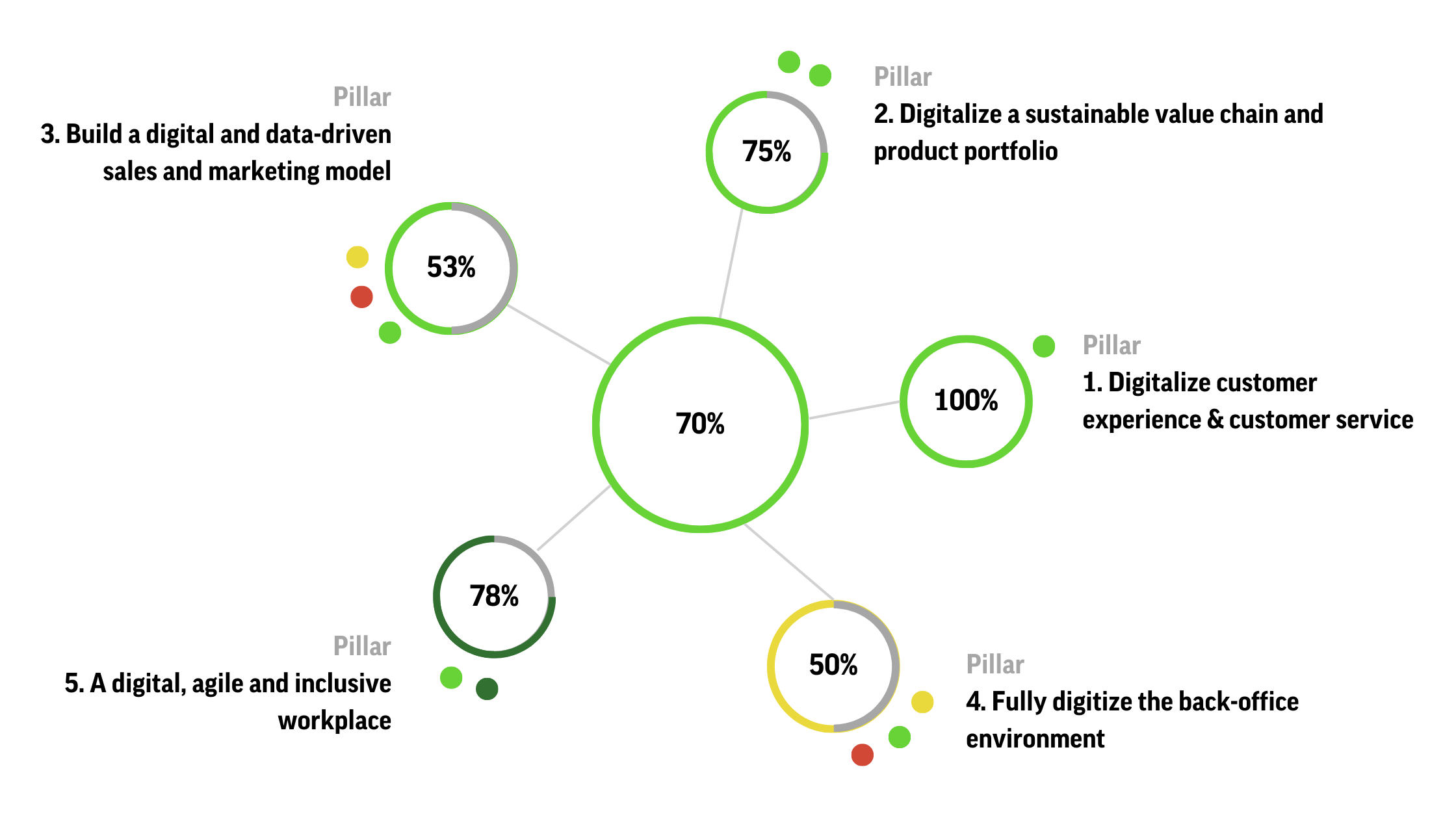How to Succeed with Digital Transformation

Digital transformation is a crucial step for any organization in any industry. The seven steps outlined in this article help you prepare and initiate a robust and effective execution management process for your digital strategy development. In addition, you'll get answers to some basic questions about digital transformation and what you need to know before you start on your journey.
What is a digital transformation strategy?
Digital transformation is the rapid emergence and convergence of a wide spectrum of technologies that have substantially changed the landscape of all industries and organizations, private and public.
The first digital technology stack was referred to as SMAC (Social, Mobile, Analytics, and Cloud), but rapidly expanded to include Additive Manufacturing, Blockchain, Internet of Things, Intelligent Robots, Autonomous Vehicles, and Immersive Technologies (to name a few). As these technologies continue to develop quickly, new ones with even more promising capabilities loom on the horizon—like quantum computing.
For the enterprise, these technologies impact everything from the value proposition and experience to their customers, to how back-offices and supply chains are managed and interact with the external world.
A key factor in competitiveness
Boundaries between the physical and the virtual world have become blurred, and new digital-native companies have emerged fast and furious. Data is everything in the 21st century and keeping up with tech is crucial to every organization’s survival in a continually volatile world market.
Information technology is the key differentiating factor from the competition in each industry. A digital transformation strategy is nothing more than an action plan that sets out how the enterprise can prosper in the digital world.
What is digital transformation?
New technologies appear, and mature, and sometimes die much more quickly than any product the world has known before. Enterprises must evolve their operating model to keep pace—and this is even more important for their strategic management model.
Domains that have been particularly impacted by the digital revolution (embodied by their respective giants, Amazon, Google, and Meta) include client experience, innovation management, operating models, corporate culture, and ecosystem partnerships.
Optimization vs. full-blown transformation
The scope of digital transformation varies depending on an organization’s maturity and ambition. One might optimize customer experience, productivity, or product improvements, for example. Full-blown digital transformation strategies, however, can include new products and services, value proposition, and new business models.
Factors that help define priorities include a new technology’s performance; how long it’s been on the market; its acceptance in the customer’s and employee’s cultures; and the pace at which governments adapt regulations to the new paradigm.
From analog to digital in the music industry
The music industry is a great example of how digital completely changes an industry’s landscape. When music moved from analog to digital in the 90s, requiring new playing equipment, the music was still distributed through traditional channels. At the start of the century, as the internet (3G, ADSL, etc.) and portable devices like the iPod developed, new distribution mechanisms such as Napster emerged, causing regulatory turmoil.
Streaming platforms like Spotify, Tidal, and Apple Music and the shift of music consumption from buying to renting have radically changed the economics of the industry over the last 20 years for all stakeholders—artists, producers, and consumers.
Focus on digital dexterity
Keep your team up-to-date on their digital training. Skills build confidence, which translates to a better experience and business outcomes. Learning and growth are, of course, part of any successful company’s strategy; however, it’s even more important to stay current with the tech to avoid serious disruptions in business.
Should my digital strategy framework be separate from my overall business strategy?
At this point, is digital strategy much different from normal enterprise strategy, just focused more on tech? It depends on the complexity and ambition of the organization. In a larger company, business units such as Marketing, Supply Chain, and IT benefit from digital strategies that also support the overall business strategy.
What’s a digital transformation framework?
A digital transformation framework is a formal plan for how and when an organization will change in the digital space.
The seven steps below provide a comprehensive framework for digitalization and a successful transformation strategy:
Step 1 – Desired State
In all goal-setting, the first step is to describe your desired state—where you want to end up. Make your dream real in your mind’s eye and the path to it becomes clearer. Work from the values reflected in your organization’s mission statement and vision. Then decide how to get there, and when you’d like to arrive.
Step 2 – Strategic Gap Assessment
Once the overall objectives are defined, look at the organization’s current situation and list obstacles to reaching the desired state.
Consider how the desired state will affect existing products and services, such as customer (needs and relationships), value proposition (products and services, channels), financial models (revenue models and cost structures), support services (processes, technologies, workforce competencies, ecosystem partners).
A digital transformation framework will affect how data is used and governed in the organization. High-performing digital organizations rely on fact-based, AI-supported decision-making vs. traditional organizations’ method of the rule of thumb or sheer intuition. The latest technology is often easier to learn and use than older methods, including analog.
Key lessons to learn from early digital adopters:
- Recognize the need for an open-minded business model transformation strategy
- Accept that the culture that got you where you are today won’t necessarily make you successful tomorrow
- Embrace failure as a steppingstone to success
- Maintain a sense of urgency to complete the digital transformation strategy
- Project the cost and returns of digital execution while managing board members’ expectations
- Create a customer-centric digital experience
- Empower employees to keep strategy execution flowing smoothly
Step 3 – Strategic Framework
Commonly used frameworks for formulating and implementing a strategy include Management by Objectives (MBO); Balanced Scorecard (BSC); The Four Dimensions of Execution (4DX); Objectives and Key Results (OKR); and Pillars and Critical Factors (PCF).
These methods are all designed as hierarchies and offer the following benefits:
- A clear overview of the corporate mission, vision, goals, and strategy
- A breakdown of these elements into specific focus areas, with accompanying goals
- A list of strategic initiatives for each focus area
- A method to encourage team member alignment with the overall strategy

Step 4 – Must-Win Battles
Strategy is about defining priorities—particularly those must-win battles. This is especially true for digital transformation, since the scope and consequences can be huge. It’s also vital to address organizational culture when contemplating major changes (particularly technological, it seems). Set your team up for success by preparing everyone for impending changes.
Step 5 – Calendar, Accountabilities & Review Cycles
Digital transformation framework typically develops in a Volatile, Uncertain, Complex, and Ambiguous (VUCA) environment, and requires more agile governance. Technologies evolve quickly, digital blurs the traditional industry and organizational boundaries, new ecosystems and competition emerge, and so on.
The objective of this step is to plan (and replan regularly) and monitor the strategy’s execution, holding the appropriate people accountable for results. Just as we make leaders adhere to budgets, they must also adhere to the strategy. As with budgets, strategic plans must be reviewed periodically in light of new developments. If this doesn’t happen, after a few months a strategy is often obsolete.
An agile strategy is a coordinated discover-design-do-evaluate sequence. It promotes continuous dialogue, and lets you plan and test while doing to create a learning cycle.
An agile strategy requires a team that is empowered to act. It also assigns accountability where it belongs: to those responsible for their own roles in the strategy‘s execution. Accountability relies on measurable results and the ability to monitor them.
Step 6 – Define KPIs
KPIs must be carefully defined—often the most difficult and time-consuming task when formulating a strategy.
What gets measured gets done is a simple truth that digital companies have taken to the next level. That's why careful action, consistency, and transparency in measuring and communicating progress are all vital to successful Strategy Execution Management. Measurements drive the right actions, which in turn drive the necessary changes. Key Performance Indicators show you how successful each action has been.
One of the most common and complicated challenges of defining a strategy is indeed defining appropriate KPIs.
To be effective, KPIs must truly be key performance indicators. Fewer KPIs are usually better than too many. The amount of data available and the speed at which it can change can create further challenges.
- Making good decisions quickly means you must consider both lagging (backward-looking) and leading (forward-looking) indicators. The latter are especially important, of course, as they’re used to check assumptions made when formulating the strategy.
- Appropriate KPIs keep everyone in the organization informed about unexpected changes in direction. During a digital transformation, it’s especially important that the organization work as one—across all functions, divisions, and silos.
- Successful organizations are six times more likely to monitor their KPIs, using real-time data.
Step 7 – Monitor
Issues will arise during strategy implementation, and a good leader is prompt to realign strategy when necessary. Responsiveness and adaptability are crucial to making the most of evolving circumstances. The executive team needs the right mindset to navigate tough times, and Strategy Execution Management (SEM) is the key.
With a strong understanding of Strategy Execution Management and
a mission-critical mindset, you’ll be prepared to successfully execute strategy
and navigate the territory ahead.
Advanced technology can now handle extremely complicated data sets and integrate them with your business's technology infrastructure. These tools enable you to track strategy execution live. It is essential that you keep trying, fail fast if you have to, and then reshape your plans. But to succeed, you need a structured approach: a very tangible plan, and instant and transparent follow-up.
Strategy in a fast-changing digital world needs to happen fast. Tracking how to transform, in what sequence, and at what time is essential. SEM increases speed by answering the following in real-time:
- What has the organization done in the last 30, 60, or 90 days to execute the strategy?
- Are the right resources in place?
- Are team members staying current on their contributions to strategic objectives?
- What are the strategic successes at any given time?
- Are the assumptions behind the strategy still relevant? If not, how can we update them and still maintain speed?
Strategy Execution Management in a digital world requires a whole system change. Aligning employees to act on and resolve strategic issues really should be non-negotiable. Manage your strategy with the same care you give to managing your finances. Make it a top priority to build trust and engagement throughout the organization.
Digital tools that give you access to any element of strategy execution at any time are only half the answer. To get the most out of the new approach to strategic governance and Strategy Execution Management, you’ll need more than your team’s cooperation—you’ll need their enthusiastic support.
The importance of knowing why, what, and how…
To succeed in a digital transformation, ask: What is it? Why is it necessary? And How will it be implemented? All three answers are vital; for example, if what and how are clear but why is not, your team might not be sufficiently motivated. They’ll participate in the implementation of a well-defined digital transformation framework—but without much enthusiasm. The results will be mixed.
If why and how are clear but what is murky, the team might be motivated—but without a clear goal, the results can be catastrophic.
If why and what are clear but how is not, you end up with frustration and demotivation. Employees may understand why frameworks for digital transformation are necessary, but they don't know how to go about implementing it. The results are average.
Is your company equipped to implement strategies successfully?
Successful strategy execution requires monitoring based on real-time data. If you can see the benefits of a data-driven approach, check out our Strategy Execution Management platform. DecideAct's solution will help you achieve and track results and engage the entire organization in executing the strategy. Book a free trial and see how.



.png?width=596&name=Strategy%20Evaluation%20(1).png)




